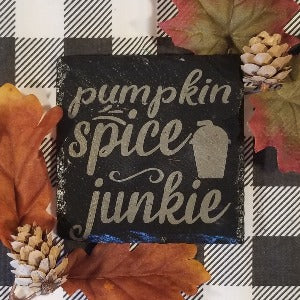11 Tips for Cleaning and Caring for Laser Engraved Slate Coasters
11 Tips for caring for your slate coasters!
What exactly is slate? Slate is a rock made from fine-grained sediments like mud or volcanic ash that was laid down millions of years ago in layers that are known as bedding. As the pile of sediments built up and thickened, the original structure of the mud was squished into a mudstone or shale. Then powerful geological forces associated with mountain building metamorphosed the natural minerals into slate. Quartz grains flattened and stretched, and clay minerals are recrystallized as platy minerals of white mica and chlorite. The quartz gives the slate strength and durability, while the mica and chlorite form cleavage planes, which do not correspond to the bedding planes, but which allow the rock to be split into much thinner slabs suitable as roofing or flooring tiles. The quality of the slates is impacted by the composition of the mudstone and the level of metamorphism.

2. Do not put your coasters in the dishwasher!!! Slate is made in layers. The power of the dish washer water jets can get between the layers and split the layers. Hand wash only!!!

3. Removing Stains: If your slate coaster has stains, it may need more careful attention than just a general clean. Here are the steps to dealing with stains: Wipe spills immediately with a cloth or towel so it doesn’t sink into the porous surface. Dip the cloth in a mild cleaning detergent like Dawn Dish soap and gently rub the stain to remove it. Hydrogen peroxide contains a mild bleach that can remove stains without damage. Use equal parts water and hydrogen peroxide and apply to stain and leave it for ten minutes. Scrub with a brush or sponge and rinse with water. Rubbing alcohol – this can be effective at removing stains. Combine rubbing alcohol with plenty of water, soak a sponge and work the stain until it is removed.
4. Don't allow Spills to Sit. The quality of the slates is impacted by the composition of the mudstone and the level of metamorphism. Slate is a porous rock material and can allow water and other liquids to seep beneath the surface. This can lead to difficult-to-remove stains. So,... it's important to always wipe up spills immediately. Water can leave temporary dark spots and water marks in the stone if allowed to sit, especially on unsealed stone. Cooking grease can also leave a stain. Food and drinks that are acidic that can lead to unwanted chemical etching on the surface. Common acids to avoid include vinegar, tomato sauce, citrus, tea and wine.
5. Avoid harsh cleaners. Although slates are durable, you should avoid using very harsh or toxic cleaning products on them. Stone is a natural, porous material and can be damaged easily. It’s best not to use acidic cleaners like lemon or vinegar. Also, steer clear of abrasive chemicals like special cleaning products or bleach.
6. How to get rid of food stains. Most food remnants and stains should come away after you’ve washed them.. But sometimes stains can be persistent. A mild detergent and a little scrubbing should be your first attempt at removing any stains when you’re cleaning slates.
7. Stubborn Stains: Internet sources claim that you can mix baking soda with a little peroxide for a more effective solution to treat stains. Just combine the peroxide and baking soda in equal amounts into a paste. Apply it to the stain, wait for a few minutes and then wipe it with a cloth.
8. Rubbing alcohol can also be used to treat stains when slate cleaning. Just soak a stone in a mixture of half a cup of rubbing alcohol to four cups of water and then treat the stain by scrubbing it a little harder. If you don’t have rubbing alcohol on hand, you can try out hydrogen peroxide. Mix it with water 1:1, spray it onto the stain and allow it to settle for 10 minutes. Then simply scrub the stain and rinse it with water.
9. Bicarbonate of soda and water paste can be used on stubborn stains. Apply paste to stain, leave for 15 minutes, wash off and dry.

10 Removing Scratches: Slate can become scratched, which can add a level of character to the surface, but too many or too deep scratches can ruin the floor’s beautiful aesthetic. There are a few techniques that can remove or hide scratches from a slate floor’s surface: Clean and dry the area and work it with mineral oil on a cloth. The darkening effect will help hide minor scuffs. Stain pens – they can be used to match the scratch to the color of the slate. Clean and dry the area and wipe the pen on the scratch and wipe to blend the scratched area into the slate’s surface, matching the colors. Sanding – fine-grit sandpaper can be used gently to achieve a polished look and remove scratches. Wipe away dust with a damp cloth afterwards.

